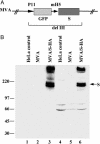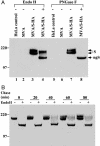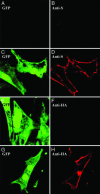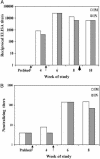Severe acute respiratory syndrome coronavirus spike protein expressed by attenuated vaccinia virus protectively immunizes mice
- PMID: 15096611
- PMCID: PMC404098
- DOI: 10.1073/pnas.0401939101
Severe acute respiratory syndrome coronavirus spike protein expressed by attenuated vaccinia virus protectively immunizes mice
Abstract
The spike protein (S), a membrane component of severe acute respiratory syndrome coronavirus (SARS-CoV) is anticipated to be an important component of candidate vaccines. We constructed recombinant forms of the highly attenuated modified vaccinia virus Ankara (MVA) containing the gene encoding full-length SARS-CoV S with and without a C-terminal epitope tag called MVA/S-HA and MVA/S, respectively. Cells infected with MVA/Sor MVA/S-HA synthesized a 200-kDa protein, which was recognized by antibody raised against a synthetic peptide of SARS-CoV S or the epitope tag in Western blot analyses. Further studies indicated that S was N-glycosylated and migrated in SDS polyacrylamide gels with an apparent mass of approximately 160 kDa after treatment with peptide N-glycosidase F. The acquisition of resistance to endoglycosidase H indicated trafficking of S to the medial Golgi compartment, and confocal microscopy showed that S was transported to the cell surface. Intranasal or intramuscular inoculations of BALB/c mice with MVA/S produced serum antibodies that recognized the SARS S in ELISA and neutralized SARS-CoV in vitro. Moreover, MVA/S administered by either route elicited protective immunity, as shown by reduced titers of SARS-CoV in the upper and lower respiratory tracts of mice after challenge. Passive transfer of serum from mice immunized with MVA/S to naïve mice also reduced the replication of SARS-CoV in the respiratory tract after challenge, demonstrating a role for antibody to S in protection. The attenuated nature of MVA and the ability of MVA/S to induce neutralizing antibody that protects mice support further development of this candidate vaccine.
Figures





References
-
- Drosten, C., Gunther, S., Preiser, W., van der Werf, S., Brodt, H. R., Becker, S., Rabenau, H., Panning, M., Kolesnikova, L., Fouchier, R. A. et al. (2003) N. Engl. J. Med. 348, 1967-1976. - PubMed
-
- Ksiazek, T. G., Erdman, D., Goldsmith, C. S., Zaki, S. R., Peret, T., Emery, S., Tong, S., Urbani, C., Comer, J. A., Lim, W., et al. (2003) N. Engl. J. Med. 348, 1953-1966. - PubMed
-
- Rota, P. A., Oberste, M. S., Monroe, S. S., Nix, W. A., Campagnoli, R., Icenogle, J. P., Penaranda, S., Bankamp, B., Maher, K., Chen, M. H., et al. (2003) Science 300, 1394-1399. - PubMed
MeSH terms
Substances
LinkOut - more resources
Full Text Sources
Other Literature Sources
Research Materials
Miscellaneous

